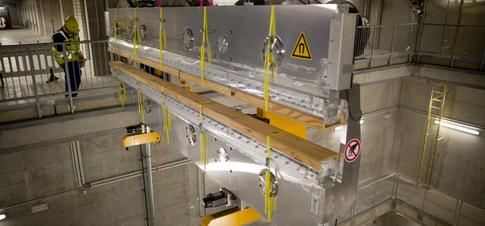XFEL: All segments of first light-generating system installed in European XFEL
All segments of first light-generating system installed in European XFEL
In the metropolitan area of Hamburg, the installation of the 35 segments of the first of three X-ray light producing components of the European XFEL has been completed. Set into one of the facility’s tunnels, the segments are the core part of three systems called undulators, which are each up to 210 metres long and will produce X-ray laser light exceeding the intensity of conventional X-ray sources by a billion times. These pulses of X-ray radiation are the basis for new revolutionary experimental techniques that will allow scientists to study the nanocosmos, with applications in many fields including biochemistry, astrophysics, and materials science. The undulator installation is a major step towards the completion of the European XFEL, a 3.4 km-long X-ray free-electron laser facility that will be the world’s brightest X-ray source when completed. It is also one of Europe’s largest research projects and is due to open to users for research in 2017.
“With the 35 segments of the first undulator beam line in place, we have clearly reached a very important milestone in the construction of our facility”, says European XFEL Managing Director Prof. Massimo Altarelli. “The X-ray flashes produced in these systems are the basis for the future research at the European XFEL. We are looking forward to 2017, when they will be used to investigate the smallest details of the structure and function of matter in the molecular world.”
Each of the 35 segments is 5 m long, weighs 7.5 t, and is composed of two girders facing one another, each holding a line of alternating strong permanent magnets. When accelerated electrons pass through the field of alternating polarity generated by the magnets, ultrashort flashes of X-ray laser light are produced. Components between adjacent segments help ensure a consistent magnetic field between them, and control systems allow mechanical movement of components within the undulator, which allows generation of a large spectrum of photon wavelengths.
Design, development, and prototyping work started approximately eight years ago in a joint collaboration with DESY, European XFEL’s largest shareholder. The same technology is also used in a number of projects at DESY, including the X-ray free-electron laser FLASH and the PETRA III storage ring light source.
The undulator system was built through a multinational collaboration. The challenging production involved DESY and Russian, German, Swiss, Italian, Slovenian, Swedish, and Chinese institutes and companies under the leadership of the undulator group of the European XFEL. This includes a number in-kind contributions such as electromagnets for the electron beamline designed and manufactured at several institutes in Russia and tested in Sweden; temperature monitoring units from the Manne Siegbahn Laboratory in Sweden; and movers, phase shifters, and control systems designed and manufactured by the research centre CIEMAT in Spain.
“This was a true synergetic collaboration”, says Joachim Pflüger, group leader of the European XFEL undulator group. “The resources and experience of DESY were essential for the development of the undulator systems. Now there is a great mutual benefit!”
This first completed undulator will generate short-wavelength “hard” X-rays that will be used for experiments with a focus on structural biology and ultrafast chemistry. All three of the undulators planned for the starting phase of the European XFEL will be operational by the end of 2016.



